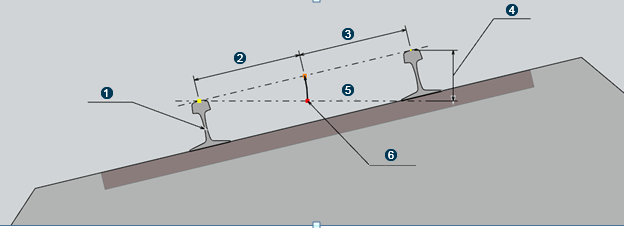About Railway | ||
| ||
The railway profile contains the following parts:

 Top.
Top.
 Head.
Head.
 Web.
Web.
 Foot.
Foot.
Railway top is the highest point on the railway head.

 Railway surface width can be symmetrical or not. It is the sum
of sleeper length and left/right ballast shoulder widths.
Railway surface width can be symmetrical or not. It is the sum
of sleeper length and left/right ballast shoulder widths.
 Track width is the distance between the two rail tops, center
to center (L distance).
Track width is the distance between the two rail tops, center
to center (L distance).
 Track gauge is the distance between the inner face of rail
heads.
Track gauge is the distance between the inner face of rail
heads.
 Rail surface offset is the distance between the rail top and
the railway surface. This distance is measured along the direction normal to
the line joining the two rail tops. Notice that this distance may be different
from the rail height.
Rail surface offset is the distance between the rail top and
the railway surface. This distance is measured along the direction normal to
the line joining the two rail tops. Notice that this distance may be different
from the rail height.
 Sleeper length is the tie length.
Sleeper length is the tie length.
 Left ballast shoulder width.
Left ballast shoulder width.
 Railway Subgrade Surface.
Railway Subgrade Surface.
 Alignment is equidistant to the two rail tops in tangent
sections.
Alignment is equidistant to the two rail tops in tangent
sections.
 Railway surface.
Railway surface.

 Inner rail is the rail among the two rails of a track that is
inside the curve.
Inner rail is the rail among the two rails of a track that is
inside the curve.
 Track width/2.
Track width/2.
 Track width/2.
Track width/2.
 Cant is the distance measured along the Z-axis between the two
rail tops (yellow dot on the tops) in a curve section. In a tangent section it
is considered that the Cant is null.
Cant is the distance measured along the Z-axis between the two
rail tops (yellow dot on the tops) in a curve section. In a tangent section it
is considered that the Cant is null.
 Horizontal. Most of the time, the inner rail is horizontally
aligned with the alignment in the curve section whilst the outer rail is above
the horizontal axis.
Horizontal. Most of the time, the inner rail is horizontally
aligned with the alignment in the curve section whilst the outer rail is above
the horizontal axis.
 Alignment. In curved section, the rail tops are superelevated
compared to the horizontal line going through the alignment. Different pivot
methods are proposed to control the rotation of railway curved sections.
Alignment. In curved section, the rail tops are superelevated
compared to the horizontal line going through the alignment. Different pivot
methods are proposed to control the rotation of railway curved sections.